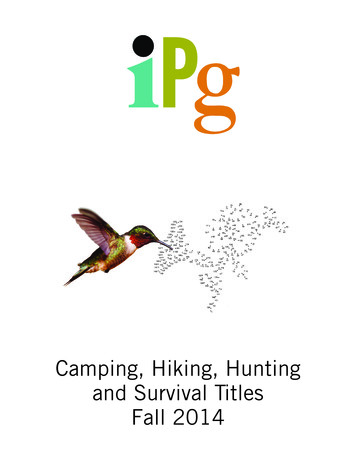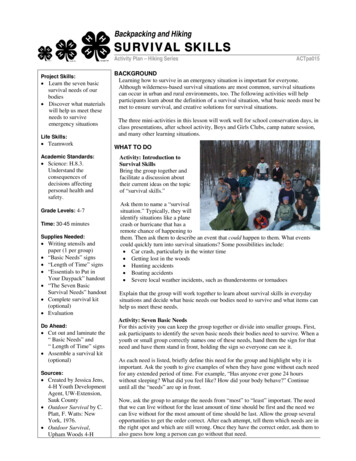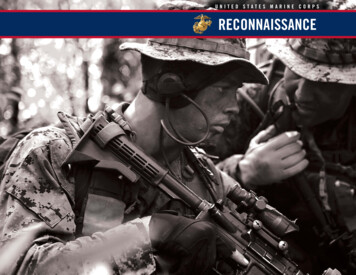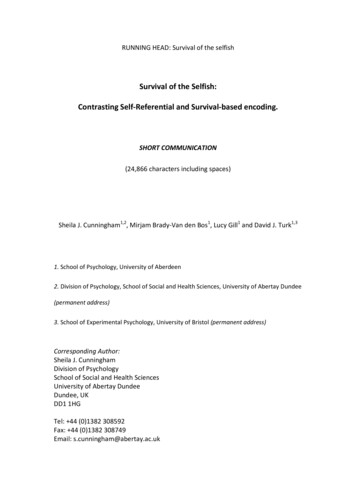
Transcription
Backpacking and HikingSURVIVAL SKILLSActivity Plan – Hiking SeriesProject Skills: Learn the seven basicsurvival needs of ourbodies Discover what materialswill help us meet theseneeds to surviveemergency situationsLife Skills: TeamworkAcademic Standards: Science: H.8.3.Understand theconsequences ofdecisions affectingpersonal health andsafety.Grade Levels: 4-7Time: 30-45 minutesSupplies Needed: Writing utensils andpaper (1 per group) “Basic Needs” signs “Length of Time” signs “Essentials to Put inYour Daypack” handout “The Seven BasicSurvival Needs” handout Complete survival kit(optional) EvaluationDo Ahead: Cut out and laminate the“ Basic Needs” and“ Length of Time” signs Assemble a survival kit(optional)Sources: Created by Jessica Jens,4-H Youth DevelopmentAgent, UW-Extension,Sauk County Outdoor Survival by C.Platt, F. Watts: NewYork, 1976. Outdoor Survival,Upham Woods 4-HACTpa015BACKGROUNDLearning how to survive in an emergency situation is important for everyone.Although wilderness-based survival situations are most common, survival situationscan occur in urban and rural environments, too. The following activities will helpparticipants learn about the definition of a survival situation, what basic needs must bemet to ensure survival, and creative solutions for survival situations.The three mini-activities in this lesson will work well for school conservation days, inclass presentations, after school activity, Boys and Girls Clubs, camp nature session,and many other learning situations.WHAT TO DOActivity: Introduction toSurvival SkillsBring the group together andfacilitate a discussion abouttheir current ideas on the topicof “survival skills.”Ask them to name a “survivalsituation.” Typically, they willidentify situations like a planecrash or hurricane that has aremote chance of happening tothem. Then ask them to describe an event that could happen to them. What eventscould quickly turn into survival situations? Some possibilities include: Car crash, particularly in the winter time Getting lost in the woods Hunting accidents Boating accidents Severe local weather incidents, such as thunderstorms or tornadoesExplain that the group will work together to learn about survival skills in everydaysituations and decide what basic needs our bodies need to survive and what items canhelp us meet these needs.Activity: Seven Basic NeedsFor this activity you can keep the group together or divide into smaller groups. First,ask participants to identify the seven basic needs their bodies need to survive. When ayouth or small group correctly names one of these needs, hand them the sign for thatneed and have them stand in front, holding the sign so everyone can see it.As each need is listed, briefly define this need for the group and highlight why it isimportant. Ask the youth to give examples of when they have gone without each needfor any extended period of time. For example, “Has anyone ever gone 24 hourswithout sleeping? What did you feel like? How did your body behave?” Continueuntil all the “needs” are up in front.Now, ask the group to arrange the needs from “most” to “least” important. The needthat we can live without for the least amount of time should be first and the need wecan live without for the most amount of time should be last. Allow the group severalopportunities to get the order correct. After each attempt, tell them which needs are inthe right spot and which are still wrong. Once they have the correct order, ask them toalso guess how long a person can go without that need.
EnvironmentalEducation Center LessonPlan, Amy ms/documents/outdoorsurvival.pdf. “Survival Skills,”Backpacker Magazine,June 1995.As they correctly come up with the answers, give the “needs” their corresponding“length of time” sign.When all of this is done, ask if there are any questions and clarify any points that theparticipants do not understand. Emphasize that they will need to know and use thisinformation in the next activity.Activity: Gilligan’s IslandDivide the group into small groups of 3-4 participants. Each group should have apiece of paper and a writing utensil.Present the following scenario to the groups: You have been ship wrecked on anisland that is exactly like where you are right now. It has the same climate,vegetation, and weather. You must survive on this island for seven days.Unfortunately, the wreckage of the airplane has disappeared. You only had time totake three things out of the airplane to help you survive. Your group may take anythree items you can think of, but all of the items must fit into a small backpack. Tellthem that electronic devices used to contact others for help do not work on thisisland. What three items did you take?Give the group about 10 minutes to discuss which three items they would have takenfrom the airplane to help them survive. When the groups are done with theirdiscussions, each group will present their three items to everyone. The groups shouldlist their three items and give reasons why they choose each item. Other groups arewelcome to ask them questions. Discuss the merits of each group’s answers and thepro and cons of their selections.Activity: Top Ten Survival ItemsThis final activity assists the youth in applying this information to an imaginarysurvival situation. When all the groups are finished, present the “Top 10 SurvivalItems” that the experts believe are important in a survival situation. The three itemseach group decided on may or may not be on this list. By presenting the “Top Ten”list, it gives the youth a chance to analyze the decision of survival skills “experts.”After the list is presented, you may want to give the youth time to talk about the listand if they agree or disagree with the items and their importance.If possible, it is nice to collect the ten items (or pictures of the items) in advance andplace them in a bag. As you discuss an item, pull it out of the bag and show it to thegroup.TALK IT OVERReflect: What is the most important thing to remember in a survival situation? What piece of information will you most likely remember? If your group was really stranded on an island, what would have been the mosthelpful thing to remember? How did your small team perform during this activity? Were you an effectiveteam?Apply: What from this activity could you apply to your life? What are some ways that you could be a more effective team member in thefuture? What new teamwork behaviors did you learn during these activities? Where elsecould you use them in your life?HELPFUL HINTSYou may switch the order of the activities by facilitating the “Gilligan Island”activity first. In this method, the youth would be involved in a hands-on activity atthe start of the lesson. By facilitating the lesson in the order presented (GilliganIsland activity after the Seven Basic Needs activity), the youth have an opportunity touse the knowledge they learned about basic needs and apply that to their group
decision in “Gilligan Island.” The order of activities is left up to the individualfacilitator.Because this lesson is meant to encourage the development of teambuilding skillsand youth/adult partnerships in its participants, it’s a good idea to keep the followingideas in mind: Youth who have pre-existing knowledge or experience in the area of survivalskills can be recruited to co-facilitate some of the activities or give examples oftheir personal experiences in survival or semi-survival situations. These youthcan also serve as team leaders or “resources” for the groups during the GilliganIsland activity. If possible, know your group ahead of time; have an idea of what size smallgroups will facilitate effective teamwork. Sometimes groups of three work well,other times groups of five may work better. Split the entire group into theoptimum-sized small groups for the Gilligan’s Island activity. Front-load the lesson and individual activities with tips for good teamwork. Forexample, before the Gilligan’s Island activity, you can highlight traits ofeffective teamwork: listening to each other, using all the team members’ skills,using a group decision-making process, and engaging all team members in thediscussion. If desired, you can break the entire group into small groups for the Seven BasicNeeds activity. Each small group may be asked to come up with a basic need asa group and then present their answer to the entire class. When the youth areworking in small teams, walk around and facilitate effective teamwork throughquestions and short discussions. Ask the entire team to present their answers, notjust one spokesperson.Reviewed by Wisconsin 4-H Curriculum Team: June 2006An EEO/AA employer, University of Wisconsin-Extension provides equal opportunities in employment andprogramming, including Title IX and American with Disabilities (ADA) requirements. 2006 by the Board ofRegents of the University of Wisconsin System. Developed by the Wisconsin 4-H Office, 431 Lowell Hall, 610Langdon St., Madison, WI 53703. The 4-H name and emblem are federally protected under Title 18 US Code 707.
The Seven Basic Survival NeedsIn any survival situation, the following seven basic needs must be met.1. PMA (Postive Mental Attitude, or “Don’t lose your head!”): The most important thing in anysurvival situation is not to panic. Your brain is your best tool for inventorying what resourcesyou have and for coming up with a plan to provide for your needs. Panic can lead to makingirrational, counter-productive decisions that actually make the situation worse, not better.How long? 3 seconds. If your car breaks through the ice on a frozen lake and you panic, youmay waste time pounding against the windows when you should be rolling them down.People have saved themselves by popping the trunk, pulling down the back seats andswimming out.2. AIR (oxygen): Although we take air for granted, in a drowning, choking, or toxic fumesituation it becomes critical to maintain an adequate supply of oxygen to the brain.How Long? 3 minutes. After that, brain cells begin to die.3. SHELTER: A shelter is used to conserve the heat your body already has. Clothing isconsidered shelter because it traps a layer of warm air and holds it next to your body. Sheltersdo not add heat. Fires or electric blankets may add heat. Would you be warmer standingoutside in winter in a swimsuit next to a fire, or in a parka and snowpants with no fire? Thebest way to keep warm is to keep from losing heat.How long? 3 hours. If you are wet and exposed to wind and/or cold temperatures, failure toseek shelter can lead to fatal hypothermia. Keeping yourself dry and out of the wind are thetwo most important assets of any shelter.4. WARMTH: If you are in an extended survival situation that may last for days, shelter alonemay not be enough to prevent frostbite and/or hypothermia. Warmth can be added throughbuilding a fire or drinking hot liquids. Physical activity of any kind will increase blood flowand raise body temperature. The body heat from a warm person can be used to add heat to acold person.How long? 3 hours-3 days: The length of time varies, depending upon conditions.5. REST (sleep): Any physical activity will burn calories – energy that cannot be used later. Restingwill conserve calories so that they may be burned slowly for warmth over time. Before anyactivity, make sure to weigh the benefits and costs, especially if you have no food to give yourselfmore energy.How long? 1-3 days: Variable, depending upon conditions. About 24 hours without sleep orrest will lead to fuzzy thinking and bad decision making for most people.6. WATER: It is possible to survive a full three days without water, but as the body dehydratesit begins to function less efficiently. Water loss can occur through breathing, sweating, andevaporation.How long? 3 days: Especially in winter, people forget to drink because they are not hot. Drinkeven before you are thirsty! Thirst is a warning signal telling you that you are alreadydehydrated. If snow is the only source of water, melt it first so you do not cool your bodytemperature by eating snow.7. FOOD: In most survival situations, food is not a top priority. However, food helps your bodystay warm by adding calories to burn and raising body temperature by activating yourmetabolism.How long? 3 weeks: Without food, your body will burn fat reserves as fuel. After fat reservesare used up, the body will begin to metabolize protein, burning muscle as a food source.
Essentials to Put in Your DaypackHere are 10 essential items that you will want to take with you on a hike . . .plus five extra optional items.1. Knife: a small, folding model with a locking-blade will do. All-purposeknives are big and bulky and tend to get left behind.2. Cigarette lighter: The plastic variety. The striker won’t work if wet, so keepit dry and warm.3. Garbage bag: You can use it as a sack for an unplanned “bivouac.” You canuse it as a rain jacket when you’re caught in a storm. You can even use it asan insulating layer by putting it on, then stuffing it with leaves or grass. Italso works well for carrying water.4. 1-2 full bottles of water.5. High-energy food like a sports bar, candy bar, or dried fruit.6. Map and compass.7. Rain gear.8. Extra warm clothes.9. Whistle and mirror for signaling.10. Small medical kit.11. Sunglasses.12. Headlamp with spare batteries and bulbs.13. Fire starter.14. Iodine for treating water.15. Emergency kit with everything from fish hooks to nylon cord.Source: “Survival Skills,” Backpacker Magazine, June, 1995.
Evaluation: Survival SkillsPlease circle the number that shows your level of understanding or learning in this session.A little12Some34A lot52. I feel confident that I will be able to usethe safety guidelines:123453. I feel confident that I adequately understandthe need for safety in order to survive:123451. I understand the basic needs for survival:Final comments:
Although wilderness-based survival situations are most common, survival situations can occur in urban and rural environments, too. The following activities will help participants learn about the definition of a survival situation, what basic needs must be met to ensure survival, and creative solutions for survival situations.










